Walking as Art
Modern Art
If a shadow is a two dimensional projection of the three- dimensional
world, then the three-dimensional world as we know it is the projection
of the four dimensional universe.
Marcel Duchamp

Nude Descending a Staircase, No. 2 (Oil on canvas, 58 inches x 35 inches)
Philadelphia Museum of Art
 Eadweard
Muybridge's attempt (1887) to depict time, the fourth dimension, on a two-dimensional
photograph was new for his time. He clearly considered himself a scientist,
as revealed by the breadth of his subjects and the blank grid he recorded
their images against. Still, his work, which made time a visual dimension,
may have influenced the art that was to follow. Although the similarities
with Muybridge's work are striking, Duchamp was in fact influenced by Étienne-Jules
Marey, as the following conversation from the book Entretiens avec
Marcel Duchamp by Pierre Cabanne (Paris, 1967, p 57) makes clear:
Eadweard
Muybridge's attempt (1887) to depict time, the fourth dimension, on a two-dimensional
photograph was new for his time. He clearly considered himself a scientist,
as revealed by the breadth of his subjects and the blank grid he recorded
their images against. Still, his work, which made time a visual dimension,
may have influenced the art that was to follow. Although the similarities
with Muybridge's work are striking, Duchamp was in fact influenced by Étienne-Jules
Marey, as the following conversation from the book Entretiens avec
Marcel Duchamp by Pierre Cabanne (Paris, 1967, p 57) makes clear:
P.C.: dans le « nu descendant un escalier », il n'y a pas
une influence du cinéma?
M.D.: bien sûr que si. C'est cette chose de Marey.
P.C.: La chronophotographie.
M.D.: Qui, j'avais vu dans l'illustration d'un livre de Marey comment
il indiquait les gens qui font de l'escrime, ou les chevaux au galop, avec
un système de pointillé délimant les différents
mouvements (.) C'est ce qui m'a donné l'idée de l'exécution
du « nu descendant un escalier ».
[I am grateful to Charl Lucassen
for this information].
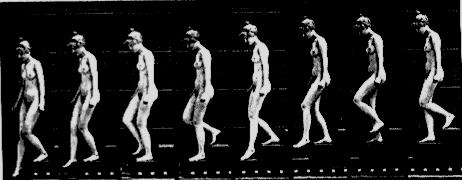
Duchamp imbues motion into two dimensions by depicting the sweeping
motions of an abstract person descending a staircase. When it was first
exhibited at the legendary Armory Show in New York (February 17-March 15,1913),
it caused an uproar which both outraged many people and made Duchamp famous
in America. One critic called it "an explosion in a shingle factory". Duchamp
removed this painting from an exhibition after complaints. Supposedly he
took it down and took it home in a taxi. It was listed in the catalogue
but not shown. Later it was used in the film Dreams
That Money Can Buy.

At the time it was painted, the Italian futurists were working along
similar lines, but Duchamp's interest in futurism, (as well as cubism,
if not painting itself), was on the wane.
Repetition of schematic lines, without any regard for anatomy or
perspective--a parallelism of lines describing movement through the different
positions of a moving person.
Duchamp
Toe upon toe, a snowing flesh,
A gold of lemon, root and rind,
She sifts in sunlight down the stairs
With nothing on. Nor on her mind.
We spy beneath the banister
A constant thresh of thigh on thigh--
Her lips imprint the swinging air
That parts to let her parts go by.
One-woman waterfall, she wears
Her slow descent like a long cape
And pausing, on the final stair
Collects her motions into shape.
X. J. Kennedy
Linda
Dalrymple Henderson: Marcel Duchamp's The King and Queen Surrounded by
Swift Nudes (1912) and the Invisible World of Electrons Weber Studies:
An Interdisciplinary Humanities Journal,14 (Winter 1997), 83-101
Duchamp
in Context - more
here
"X Rays and the Quest for Invisible Reality in the Art of Kupka, Duchamp,
and the Cubists," Art Journal, vol. 47 (Winter 1988), 323-40
Here's
a great page on the Nude Decending Stairs
from the sublime...
 Nude Descending a Staircase
(74" x 38")
Nude Descending a Staircase
(74" x 38")
I felt impelled towards a renewed disposition of this subject made
notorious with the uproar over Marcel Duchamp's entry in the 1913 Armory
Show. The theme has since become generic, as have themes such as bathers,
piping Pans, or reclining nudes.. But my own statement would not or could
not, be cast in Duchamp's cubist-futurist idiom. Serendipity led me to
the Pre-Raphaelite Sir Edward Coley Burne-Jones whose painting The Golden
Stairs suggested a scaffold for my own. His Victorian maidens, a saccharine
demiseraphic troupe, were for me quite naturally no more embraceable than
Duchamp's metallic robots. However the sweep of Burne-Jones' design provided
my nude her stage. She makes entrance, then descends to diverse portraits
comprising not only head, but body & temper - revealed step by step
as it were, in shifting colors, light, and action. After "performing" in
choreographed (sometimes mocking) descent , she exits below to Art and
to the World. (My debt to Burne-Jones is acknowledged in the lower right
hand corner of my work, where his name can be seen on a crumpled candy-wrapper.)
...to the ridiculous!
Jack Szwergold
 Nude
Descending Turkey (1999)
Nude
Descending Turkey (1999)
Pablo Picasso
 Les Demoiselles d'Avignon (1907)
Les Demoiselles d'Avignon (1907)
Oil on canvas (243.9 x 233.7 cm), The Museum of Modern Art, New York
Les Demoiselles d'Avignon is one of the most important paintings in
the genesis of modern art. Both in style and in subject matter, it represents
a radical departure from traditional modes of representation. Inspired
by Muybridge's Dropping and Lifting of a Handerchief (1885), it
pictures a moving sequence of five women (one in a biomechanically impossible
posture), undergoing a gradual geometrization (the beginnings of Cubism)
as the 'action' progresses from left to right. It ends in a 4D view of
the squatting whore, who symbolizes the ravages of syphillis.
"You've been trying to paint the fourth dimension. How amusing!"
Leo Stein
Francis Bacon (1909-1992)

Bacon emphasised the key role of Muybridge in his artistic development,
asserting that it was difficult to disentangle the photographer's influence
from that of Michelangelo: the two of them, he said, 'are mixed up in my
mind together'.
 In
Woman
Emptying a Bowl of Water, and Paralytic Child on All Fours (1965),
Bacon lifted both his subjects straight from from Muybridge. Bacon’s painting
features two grotesque naked figures enigmatically perched on opposite
sides of the catwalk- the crouching woman employing her bowl of water and
the disfigured child on all fours.
In
Woman
Emptying a Bowl of Water, and Paralytic Child on All Fours (1965),
Bacon lifted both his subjects straight from from Muybridge. Bacon’s painting
features two grotesque naked figures enigmatically perched on opposite
sides of the catwalk- the crouching woman employing her bowl of water and
the disfigured child on all fours.

Running Man, 1932-34; Oil on canvas, 79 x 65 cm (31 1/8 x 25 5/8 in);
Musee National d'Art Moderne, Paris
Roy Lichtenstein

Artist's Studio Foot Medication, Original Oil On Canvas 243.8 x 325cm

Foot Medication Poster, lithograph,16" x 16" inches, edition 100

Foot And Hand, 1964, Offset Lithograph on white wove paper , 17" x
21" inches, edition 300
Umberto Boccioni
 Unique Forms in
the Continuity of Space
Unique Forms in
the Continuity of Space
(1913) Bronze (1264 x 890 x 406), Private Collection, Rome
The Italian and Russian Futurists such as Russolo, Boccioni, Larionov
and Goncharova, attempted to represent movement: an approach known as "dynamism".
Universal dynamism must be rendered as dynamic sensation ... motion
and light destroy the substance of objects.
Futurist manifesto
 the
Italian 20 Eurocent
the
Italian 20 Eurocent
 Muscular Dynamism (1913)
Muscular Dynamism (1913)
Charcoal on paper (864 x 591), Museum of Modern Art, New York
LS Lowry
 The Cripples (1949)
The Cripples (1949)
One of the founders of Futurism, signing the Futurist Manifesto which was published in 1910. In this document Balla, along with artists including Umberto Boccioni and Carlo Carrà, outlined their primary objective to depict movement, which they saw as symbolic of their commitment to the dynamic forward thrust of the twentieth century. Futurism celebrated the machine - the racing car was heralded as the triumph of the age - and early futurist paintings were concerned with capturing figures and objects in motion. In [his] Girl Running on the Balcony, Balla attempted to realize movement by showing the girl's running legs in repeated sequence. Other paintings, such as Dog on a Leash, got to grips with the problem of recreating speed and flight by superimposing several images on top of each other. Inevitably, the advances that were made by this short-lived movement were eventually to be overtaken by the art of cinematography. Futurism was finished by the First World War, after which Futurist ideals became increasingly associated with Fascism. Balla began to plough an independent path, at first toward abstraction and, after 1931, toward figuration.
 Girl Running on a
Balcony (1912)
Girl Running on a
Balcony (1912)
1250 x 1250, Civica Galleria d'Arte Moderna, Milan
 Technical Study
for 'Girl Running on a Balcony'
Technical Study
for 'Girl Running on a Balcony'
Ink and pencil on card (240 x 265), Private Collection
 Technical Study
for 'Girl Running on a Balcony'
Technical Study
for 'Girl Running on a Balcony'
(Ink and pencil on card (170 x 245), Civica Galleria d'Arte Moderna,
Milan
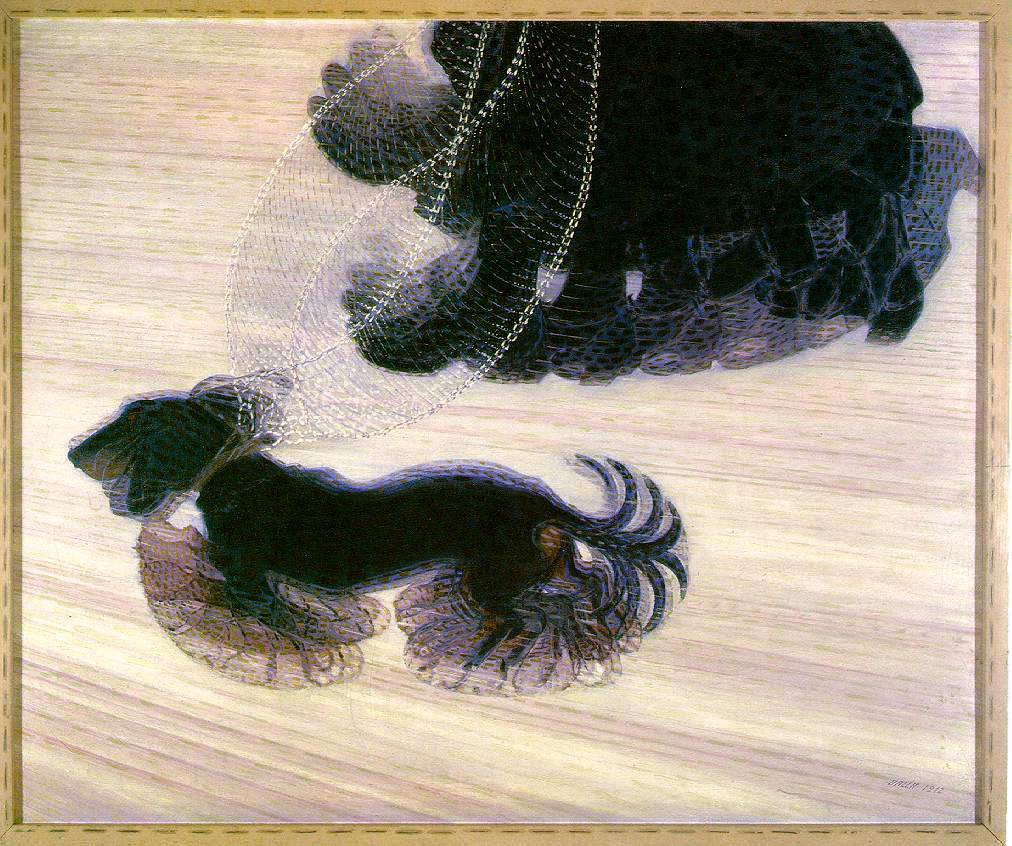
Dynamism of a Dog on a Leash, 1912 (Albright-Knox Art Gallery, Buffalo, New York)
Henri de Toulouse-Lautrec
Toulouse-Lautrec was of weak constitution as a child, perhaps due to the
fact that his parents were first cousins. It was suggested that he had
osteogenesis imperfecta. In 1878 he broke both legs, and spent his convalescence
drawing and painting. However, after the fractures, his legs stopped growing,
although his torso matured normally. As his adolescence progressed, he
became "a grotesque dwarf (4.5 feet), with a thick nose, swollen and puffy
lips, a retreating chin, and a strange waddling walk." Deprived of the
physical life that a normal body would have permitted, Toulouse-Lautrec
lived completely for his art.
He was a regular at the Moulin Rouge, for which he painted cheerful
posters. He lived the high life, and adored wine and women, albeit a tad
too much. By the mid 1890s he had contracted syphilis and was a chronic
alcoholic. His alcoholism was taking its toll on his heart and his art.
In 1899 he suffered delirium tremens, and was admitted to a clinic, where
he drew from memory, a series of circus drawings. Upon discharge, he started
drinking again. In 1901 he was struck down by a paralytic stroke and was
forced to give up painting.

Cripples Frightened By Cosmic Downsizing (1996)
Color aquatint with flat bite etching, soft ground etching and drypoint
on Somerset Textured White Paper (51-1/4 x 40-3/4")

Cripples Discussing Cosmic Downsizing (1996)
Hard ground etching with aquatint and drypoint on Hosho Paper (6-3/4
x 33")
Paul Delvaux: The 'Sleepwalker of Saint-Idesbald' (1897-1994)
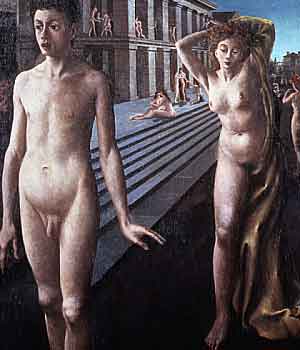 Known
as the 'Sleepwalker of Saint-Idesbald' Paul Delvaux was the last surviving
member of the first generation of Surrealist painters. Paul Delvaux was
born on September 23, 1897, in Antheit, Belgium. At the Académie
Royale des Beaux-Arts in Brussels he studied architecture from 1916 to
1917 and decorative painting from 1918 to 1919. During the early 1920s
he was
Known
as the 'Sleepwalker of Saint-Idesbald' Paul Delvaux was the last surviving
member of the first generation of Surrealist painters. Paul Delvaux was
born on September 23, 1897, in Antheit, Belgium. At the Académie
Royale des Beaux-Arts in Brussels he studied architecture from 1916 to
1917 and decorative painting from 1918 to 1919. During the early 1920s
he was
influenced by James Ensor and Gustave De Smet. In 1936 Delvaux shared
an exhibition at the Palais des Beaux-Arts in
Brussels with René Magritte, a fellow member of the Belgian
group Les Compagnons de l’Art.
One of a variety of movements associated with sleep called the parasomnias.
The term somnambulism comes from the Latin words for sleep (somnus)
and walking (ambulus). A typical sleepwalking episode is rather
short. Sleep walking occurs during stages 3 and 4, the deepest state of
sleep. This observation lead to the conclusion that the sleepwalkers are
not acting out their dreams. Various possible causes of somnambulism are
known, however, none are definite. For example, stress and anxiety can
cause sleep walking, however, the precise mechanisms are not known.
Anna Freud, Sigmund's daughter did a lot of investigative work on this
subject and sleepwalking is a relatively "normal" finding in the pediatric
population. Normal children can sleep walk and they generally outgrow the
problem by age 15. Almost 20 - 40 percent in some people's studies. There
appears to be a genetic or inherited factor as it often runs in families,
but as we age, the phenomena of sleep walking generally resolves. Psychologists
and other investigators have shown that children who sleep walk are usually
normal in every respect but a few studies have suggested that in some of
the parasomnias some children may have inner conflicts that they are not
able to verbalize. And in a few cases, family counseling and reassurance
have been all the therapy necessary in patients with frequent parasomnias.
So there appears to be a tendency for children to have this, a tendency
for an inherited component, and especially as the patient becomes older,
a possible psychological element. And as such all the factors you mentioned
may come into play to some degree. 
According to the International Classification of Sleep Disorders,
severe sleep walking is considered as occurring greater than or equal to
1 time per week. Some statistics suggest that 1 percent or less of the
adult population may sleep walk. Adults who sleep walk often have strong
underlying psychological difficulties that may be responsible in some way
for the
nighttime behavior. In some reports, fever with illness, sleep deprivation,
the excessive use of certain drugs may also make
sleep walking worse. In these cases, as stated before, in an attempts
to prevent further sleep walking episodes, the
neuropsychologists in our insomnia clinic will thoroughly evaluate
for these possibilities and then institute appropriate behavioral,
cognitive or recommend medications that might be deemed appropriate
for what would otherwise the primary problems. When
we have an otherwise normal individual, child or adult, who for example
would like to go on a mountain-side campout, where
 sleep
walking could be life threatening, we often recommend a single night 's
use of a medicine in the group of drugs called
sleep
walking could be life threatening, we often recommend a single night 's
use of a medicine in the group of drugs called
benzodiazepines. These medications insert a fast brain wave activity
that in some regards parallels a
disruption of the normal deep delta brain wave pattern from where sleep
walking generally arises. As such, a marked reduction
in the capacity to sleep walk is generally appreciated. Nevertheless,
there are many hazards that are possible with the chronic
use of these medications, although there use can be considered in severe
cases.
It is important to realize that sleepwalkers are actually sleeping.
If you try to wake them up, it is potentially very threatening to this
confused/sleeping individual. The attempt to awake a sleepwalker has been
the general period of time where there have been reports of relative violence
as the confused patient may in some respects try to defend themselves or
fend off the individual who may appear in some regard to be attacking them.
Usually it is best to gently lead the patient back to their room without
any active attempts to awaken them. This is routine associated with no
major problems.
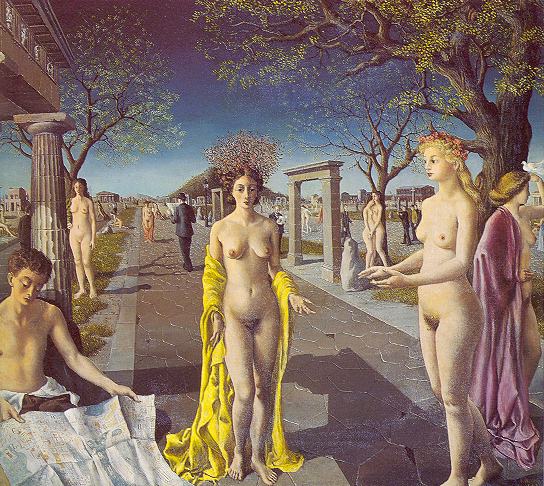
 Walk on the Cliffs,
Mixed Media
Walk on the Cliffs,
Mixed Media
Ivan Tovar

Esqueleto (1963), Museum of Modern Art, Santo Domingo, Dominican Republic
Manuel Motilla
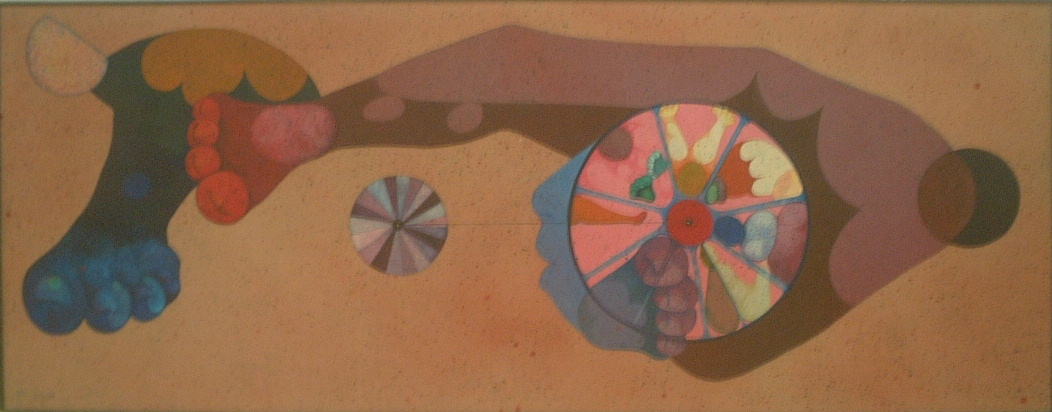
El Hombre que arrastra sus problemas (1982), Museum of Modern Art,
Santo Domingo, Dominican Republic
 The
impish, crumple-suited Nikita Khrushchev, inspired by the late communist
leader's famous, late 1950's shoe banging at the United Nations, holds
more than a bit of irony. The shoe Goutman uses was his father's, for whom
communism was a decided sore point.
The
impish, crumple-suited Nikita Khrushchev, inspired by the late communist
leader's famous, late 1950's shoe banging at the United Nations, holds
more than a bit of irony. The shoe Goutman uses was his father's, for whom
communism was a decided sore point.
"My father did not permit even the mention of Lenin's name in our house,"
recalls Goutman. A prosperous Czarist industrialist, the senior Goutman
lost most of his worldly goods under the communist rule of the early leader
of the former Soviet Union.
The Goutmans emigrated to Latvia and then Holland, before being allowed
to enter the United States in 1931. After studying art in Detroit, young
Goutman attended the Art Institute of Chicago, where he won a $2,500 Traveling
Fellowship.
Steven Pippin

Running Naked consists of 12 black and white photographs of a figure
in motion taken from inside washing machines in an American launderette.
 Eadweard
Muybridge's attempt (1887) to depict time, the fourth dimension, on a two-dimensional
photograph was new for his time. He clearly considered himself a scientist,
as revealed by the breadth of his subjects and the blank grid he recorded
their images against. Still, his work, which made time a visual dimension,
may have influenced the art that was to follow. Although the similarities
with Muybridge's work are striking, Duchamp was in fact influenced by Étienne-Jules
Marey, as the following conversation from the book Entretiens avec
Marcel Duchamp by Pierre Cabanne (Paris, 1967, p 57) makes clear:
Eadweard
Muybridge's attempt (1887) to depict time, the fourth dimension, on a two-dimensional
photograph was new for his time. He clearly considered himself a scientist,
as revealed by the breadth of his subjects and the blank grid he recorded
their images against. Still, his work, which made time a visual dimension,
may have influenced the art that was to follow. Although the similarities
with Muybridge's work are striking, Duchamp was in fact influenced by Étienne-Jules
Marey, as the following conversation from the book Entretiens avec
Marcel Duchamp by Pierre Cabanne (Paris, 1967, p 57) makes clear:


 Nude Descending a Staircase
(74" x 38")
Nude Descending a Staircase
(74" x 38")
 Nude
Descending Turkey (1999)
Nude
Descending Turkey (1999)
 Les Demoiselles d'Avignon (1907)
Les Demoiselles d'Avignon (1907)

 In
Woman
Emptying a Bowl of Water, and Paralytic Child on All Fours (1965),
Bacon lifted both his subjects straight from from Muybridge. Bacon’s painting
features two grotesque naked figures enigmatically perched on opposite
sides of the catwalk- the crouching woman employing her bowl of water and
the disfigured child on all fours.
In
Woman
Emptying a Bowl of Water, and Paralytic Child on All Fours (1965),
Bacon lifted both his subjects straight from from Muybridge. Bacon’s painting
features two grotesque naked figures enigmatically perched on opposite
sides of the catwalk- the crouching woman employing her bowl of water and
the disfigured child on all fours.



 Unique Forms in
the Continuity of Space
Unique Forms in
the Continuity of Space
 the
Italian 20 Eurocent
the
Italian 20 Eurocent
 Muscular Dynamism (1913)
Muscular Dynamism (1913)
 Girl Running on a
Balcony (1912)
Girl Running on a
Balcony (1912)
 Technical Study
for 'Girl Running on a Balcony'
Technical Study
for 'Girl Running on a Balcony'
 Technical Study
for 'Girl Running on a Balcony'
Technical Study
for 'Girl Running on a Balcony'


 Known
as the 'Sleepwalker of Saint-Idesbald' Paul Delvaux was the last surviving
member of the first generation of Surrealist painters. Paul Delvaux was
born on September 23, 1897, in Antheit, Belgium. At the Académie
Royale des Beaux-Arts in Brussels he studied architecture from 1916 to
1917 and decorative painting from 1918 to 1919. During the early 1920s
he was
Known
as the 'Sleepwalker of Saint-Idesbald' Paul Delvaux was the last surviving
member of the first generation of Surrealist painters. Paul Delvaux was
born on September 23, 1897, in Antheit, Belgium. At the Académie
Royale des Beaux-Arts in Brussels he studied architecture from 1916 to
1917 and decorative painting from 1918 to 1919. During the early 1920s
he was

 sleep
walking could be life threatening, we often recommend a single night 's
use of a medicine in the group of drugs called
sleep
walking could be life threatening, we often recommend a single night 's
use of a medicine in the group of drugs called

 Walk on the Cliffs,
Mixed Media
Walk on the Cliffs,
Mixed Media
 The
impish, crumple-suited Nikita Khrushchev, inspired by the late communist
leader's famous, late 1950's shoe banging at the United Nations, holds
more than a bit of irony. The shoe Goutman uses was his father's, for whom
communism was a decided sore point.
The
impish, crumple-suited Nikita Khrushchev, inspired by the late communist
leader's famous, late 1950's shoe banging at the United Nations, holds
more than a bit of irony. The shoe Goutman uses was his father's, for whom
communism was a decided sore point.